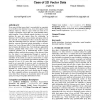Free Online Productivity Tools
i2Speak
i2Symbol
i2OCR
iTex2Img
iWeb2Print
iWeb2Shot
i2Type
iPdf2Split
iPdf2Merge
i2Bopomofo
i2Arabic
i2Style
i2Image
i2PDF
iLatex2Rtf
Sci2ools
241
Voted
GIS
2006
ACM
2006
ACM
Object localization based on directional information case of 2D vector data
If you were told that some object A was perfectly (or somewhat, or not at all) in some direction (e.g., west, above-right) of some reference object B, where in space would you look for A? Cognitive experiments suggest that you would mentally build a spatial template. Using essentially angular deviation, you would partition the space into regions where the relationship "in direction of B" holds (to various extents) and regions where it does not hold. You would then be able to locate the objects for which the relationship holds best, and find A. Spatial templates, therefore, represent directional spatial relationships to reference objects (e.g., "east of the post office"). Note that other names can also be found in the literature (e.g., fuzzy landscape, applicability structure, potential field). There exists a very simple and yet cognitively plausible way to mathematically model a spatial template without sacrificing the geometry of the reference object (i.e., the ob...
Related Content
| Added | 11 Nov 2009 |
| Updated | 11 Nov 2009 |
| Type | Conference |
| Year | 2006 |
| Where | GIS |
| Authors | Stelian Coros, JingBo Ni, Pascal Matsakis |
Comments (0)

